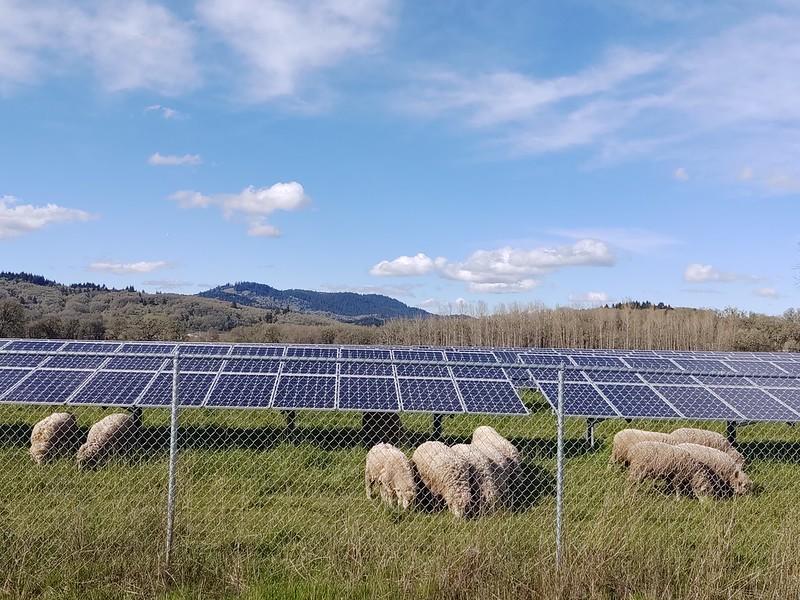Study finds money poured into rural Oregon under Biden-era programs recently cut by Republicans
Published 6:36 am Friday, August 1, 2025

- In solar grazing farms, sheep and other livestock are able to eat weeds, grasses and plants on the same land that’s used to host solar panels for clean energy generation. In Oregon, federal investments in energy and environment projects in rural counties and economically distressed counties doubled between 2010 and 2024, a new Portland State University study found. (Oregon State University)
A study by researchers at Portland State University found federal investments in Oregon’s rural and economically stressed counties doubled since 2010
A Biden-era program to ensure 40% of new federal climate, housing, clean energy and clean water funding went to projects and programs in historically underserved communities led to major investments in rural Oregon and to tribes, a new study revealed.
But many of those investments are now being cut or scaled back in the federal tax and spending cut megabill Republicans passed in July.
Researchers at Portland State University and the nonprofit Seattle-based Northwest Environmental Justice Center analyzed federal spending patterns between 2010 and 2024 on 468 energy, environment and infrastructure programs across the country. Overall, federal agencies sent about $2.24 trillion to state and local governments, tribes and private companies, nonprofits, individuals and higher education institutions across the country for energy and environmental infrastructure programs from 2010 to 2024.
Trending
The share of that money benefiting rural counties and economically distressed counties nationwide more than tripled in the last decade, the researchers found, and accelerated dramatically after former President Joe Biden issued an executive order creating the Justice40 Initiative to direct 40% of new federal climate and clean energy spending to underserved communities.
Historic investments in clean energy, infrastructure and environmental protection projects followed under the Infrastructure Investment and Jobs Act that passed in 2021 and the Inflation Reduction Act that passed in 2022.
“I would say that if you look at the change of proportional investment in rural communities and tribes over time, in particular the last couple years, what the federal programs were doing was working,” said Bobby Cochran, a senior project manager at Portland State University’s Hatfield School of Government and one of the co-authors of the report.
But in March, President Donald Trump terminated the Justice40 Initiative. And Lee Zeldin, head of the federal Environmental Protection Agency, cancelled more than a billion worth of grants related to environmental justice.
Of the more than 400 federal grant programs that researchers analyzed, Republicans cut or scaled back 30 of them that provided about half of all federal energy and environment money to Oregon in 2024.
Investments in rural Oregon, tribes
In Oregon, investments in rural counties and economically distressed counties doubled between 2010 and 2024, Cochran and his team found. Tribes in Oregon received 20 times the amount in 2024 that they received in 2010.
Trending
Funding for Oregon’s nine federally recognized tribes increased from about $14.45 million in 2010 to more than $324 million by 2024.
Of the more than $30 billion from the federal government that flowed to Oregon energy and environment programs during between 2010 and 2024, about 20% — more than $6 billion — went to rural or economically distressed counties in Oregon.
Sherman, Gilliam, Wallowa, Benton and Baker counties received the most per capita federal energy and environmental protection funding through the Biden-era energy and investment programs.
Researchers also looked at how money flowed in each of the state’s congressional districts.
Northwest Oregon’s 1st Congressional District, represented by U.S. Rep. Suzanne Bonamici, a Democrat, received the most federal funding for energy environment projects in 2024. Her district got nearly $700 million.
The 2nd Congressional District, repped by the state’s lone Republican congressman, Cliff Bentz, received the second highest proportion of federal funding for energy and environmental protection projects — more than $470 million. Bentz voted against the Inflation Reduction and Infrastructure, Investment and Jobs acts, and voted to pass the recent Republican tax bill that rolls back funding spurred by those acts.
Nationally, slightly more money went to Democratic-led Congressional districts than Republican-led ones, but it was mostly even over the 10 years analyzed, Cochran said.
In 2024, about 57% of energy and environmental infrastructure investment was distributed to Democrat-held districts and 43% to Republican-held districts.
“It doesn’t appear that there’s anything political going on,” he said.
Among the cuts
Among the EPA grants cut by Zeldin was the one providing the funding for Cochran and his collaborators’ work, which also includes providing technical assistance to people, groups and governments applying for federal energy, infrastructure and environment grants in Oregon.
The five-year grant they received in 2023 was terminated by the EPA in May, and with it, $8 million in funding. The reason? The work was “inconsistent with federal administration priorities,” Cochran said.
He said in one year, they had provided technical assistance statewide that helped bring in about $50 million to groups and local governments.
The study of where federal money is and has flowed, he said, was supposed to help them understand where people are succeeding in getting more federal dollars, and where they could use help from people like him.
“That’s why we started this,” he said. “To say, ‘Hey, is anybody getting left behind?’”






